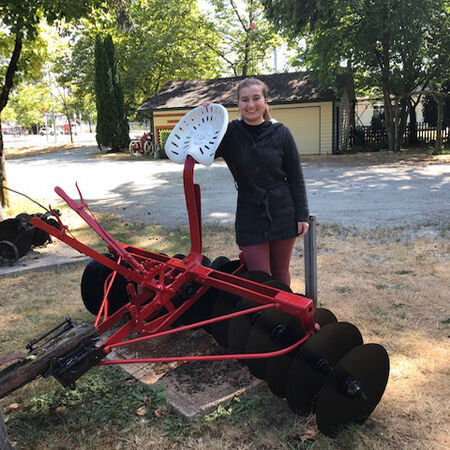
 604 465 4322
604 465 4322General Store Site 12294 Harris Road Pitt Meadows, B.C.
Click Here for Directions& Visiting Hours

Artifact Restoration with Rachel
YCW Summer Student Rachel on her summer at the Pitt Meadows Museum. Here she is posed with a Massey Harris disker - one of the farm machinery she worked on this summer.
My name is Rachel. I am entering my first year of an MA in Classical Art and Architecture at Brock University after finishing my Honors BA in an Honours Specialization in Creative Writing, English Language, and Literature with a Major in Classical Studies. I came to work at the Pitt Meadows Museum and Archives because I am interested in pursuing a career in archaeology. As such, I was excited to take the position in order to both learn about how to work with artifacts and how museums work behind the scenes as well as gain work experience that is applicable to my studies and career goals.
My task this summer was to identify, research, and restore the outdoor artifacts behind the General Store that had yet to be restored. In the time I spent working on this task, I was able to identify most of the types of machines, the companies that made them, and the general periods they were from. After identifying the types of machines and the companies that made them, I began researching the history behind the machines and the companies to learn the background of each type of machine, the companies, to know how they were used, what materials they were made of, and what colours of paint were used upon manufacture.
The easiest information to gather was the types of machines each implement because the machines are largely intact so a visual observation and cross reference with types of agricultural equipment was all that was required to find that piece of information. Finding the companies the machines belong to was a more difficult task because I had to scour the surface of each machine to locate any identifying marks such as trade-marks, serial numbers, part numbers, “made in…” tags, and company names. Once this information was gathered, I then looked up resources both online and in physical books that could be used to identify the exact, or as close to, implements we have. It proved very difficult to identify the exact models for many of the implements because there are many adaptations of each implement and because of this, I have had to resort to identifying likely date ranges for the implements. I have narrowed down the date ranges based on the parts of the implements that match those shown and/or described in catalogues or similar texts and compared these dates to those recorded when the implements were donated to the museum. Once all of that information was known, I began the messy task of cleaning the implements in preparation for painting. All of the cleaning and painting has been done by hand. It has proved to be difficult work, but seeing the cleaned, and then painted stages of the implements has been rewarding.
When not cleaning or painting the implements, I have spent time collecting the information I have gathered about the implements and companies to write quick summaries about what the implements are, how they were used, and which company each belongs to and which models they are. I have also gathered information about the companies to make short summaries of the different companies.
My task this summer was to identify, research, and restore the outdoor artifacts behind the General Store that had yet to be restored. In the time I spent working on this task, I was able to identify most of the types of machines, the companies that made them, and the general periods they were from. After identifying the types of machines and the companies that made them, I began researching the history behind the machines and the companies to learn the background of each type of machine, the companies, to know how they were used, what materials they were made of, and what colours of paint were used upon manufacture.
The easiest information to gather was the types of machines each implement because the machines are largely intact so a visual observation and cross reference with types of agricultural equipment was all that was required to find that piece of information. Finding the companies the machines belong to was a more difficult task because I had to scour the surface of each machine to locate any identifying marks such as trade-marks, serial numbers, part numbers, “made in…” tags, and company names. Once this information was gathered, I then looked up resources both online and in physical books that could be used to identify the exact, or as close to, implements we have. It proved very difficult to identify the exact models for many of the implements because there are many adaptations of each implement and because of this, I have had to resort to identifying likely date ranges for the implements. I have narrowed down the date ranges based on the parts of the implements that match those shown and/or described in catalogues or similar texts and compared these dates to those recorded when the implements were donated to the museum. Once all of that information was known, I began the messy task of cleaning the implements in preparation for painting. All of the cleaning and painting has been done by hand. It has proved to be difficult work, but seeing the cleaned, and then painted stages of the implements has been rewarding.
When not cleaning or painting the implements, I have spent time collecting the information I have gathered about the implements and companies to write quick summaries about what the implements are, how they were used, and which company each belongs to and which models they are. I have also gathered information about the companies to make short summaries of the different companies.
August 2022.





